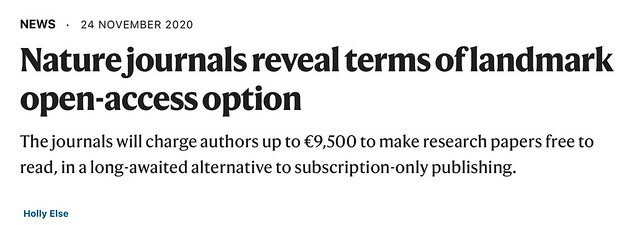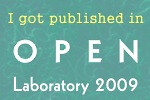A news article published online in Nature this morning discusses the announcement of new open access options in the Nature family of journals.
The details are in the article, but the basic story (written by Holly Else) is that authors wanting to make their work OA can pay an APC of €9,500 or choose a ‘guided’ route, which is about 50% cheaper but splits the price between reviewing and publishing.
I am quoted briefly in the piece but, as is often the way when you are approached by a journalist for comment, there is much more to say that there is room in the article. So, given that I had devoted a chunk of my free time on Saturday morning to answering Holly’s questions, I thought I would post my complete answers here. These will make more sense if you read her article first to understand the new OA options at Nature journals.
1) What do you think of the costs of publishing OA in Nature?
It looks very expensive. In part that is because most academics have no idea of the per article cost of the subscription model, which is also very expensive. Clearly, there are costs associated with being selective but I wonder if the introduction of this pricing structure will make people ask if the selectivity is worth it. In part the selectivity is driven by arbitrarily limiting the number of papers published in each Nature title. So the filtering is done both for quality and the limit imposed on the number of pages or articles published per year. A better scheme would not artificially limit the number of articles and judge solely on quality. I suspect NPG know that they can charge these sorts of sums because they are also selling a brand that unfortunately still has far too much sway when it comes to research assessment.
2) What do you think of the guided OA approach?
It’s an interesting innovation and it is good to see this sort of experimentation. But it immediately raises questions. Why would someone pay €9500 for OA if a cheaper route is available? Also – how would reviewers feel about Nature titles essentially selling their free labour to authors (in the case where a review is done but the paper is rejected)? I think this opens up an important question about the way that commercial publishers co-opt academic labour without paying for it.
3) Do you think it offers a way to make article processing charges more affordable for selective journals?
Not really because the charges outlined (even by the guided route) are more expensive than the APC for Nature Communications, which is a selective OA journal (APC set at €4530 from Jan 2021).
4) Do you have any concerns over the way that the reduction in the APC is tied to guided approach?
Some. In addition to those noted above, while prices are transparent, costs are not. The rationale for the split of costs before and after peer review is opaque. The high cost means access to NPG titles may be limited to wealthy labs or universities willing to pay for prestige.
5) How significant is it that Nature is offering open access publishing for the first time?
Very significant. It shows that cOAlition S and the OA movement in general is winning the argument about the value of ensuring that publicly-funded research results should be freely accessible if the world is to derive maximum benefit. We have seen this in 2020 in the rush of subscription publishers to make SARS-Cov-2 research freely available during the pandemic. What works for trying to deal with Covid-19 will also work for other major challenges such as climate change, antibiotic resistance, cancer research etc.
6) What does this all mean for the future of open science and Plan S?
It marks an important step forward, albeit one loaded with caveats. It keeps the debate about the fitness of the APC model of OA alive and will hopefully stimulate even further exploration of alternative solutions.





